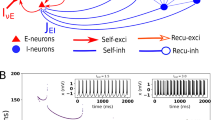Abstract.
The synapsins are a family of five closely related neuron-specific phosphoproteins associated with the membranes of synaptic vesicles. The synapsins have been implicated in the regulation of neurotransmitter release. They tether synaptic vesicles to actin filaments in a phosphorylation-dependent manner, controlling the number of vesicles available for release at the nerve terminus. A growing body of evidence suggests that the synapsins play a broad role during neuronal development. They participate in the formation and maintenance of synaptic contacts among central neurons. In addition, each synapsin has a specific role during the elongation of undifferentiated processes and their posterior differentiation into axons and dendrites. In this review, we focus on these novel roles of synapsins during the early stages of development.
Similar content being viewed by others
Author information
Authors and Affiliations
Additional information
Received 26 September 2001; received after revision 8 November 2001; accepted 9 November 2001
Rights and permissions
About this article
Cite this article
Ferreira, A., Rapoport, M. The synapsins: beyond the regulation of neurotransmitter release. CMLS, Cell. Mol. Life Sci. 59, 589–595 (2002). https://doi.org/10.1007/s00018-002-8451-5
Issue Date:
DOI: https://doi.org/10.1007/s00018-002-8451-5




